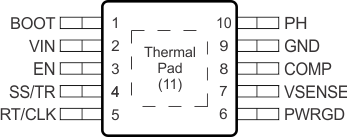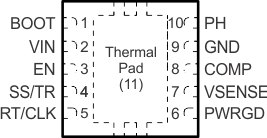SLVS919C January 2009 – September 2015 TPS54060
PRODUCTION DATA.
- 1 Features
- 2 Applications
- 3 Description
- 4 Revision History
- 5 Pin Configuration and Functions
-
6 Specifications
- 6.1 Absolute Maximum Ratings
- 6.2 ESD Ratings
- 6.3 Recommended Operating Conditions
- 6.4 Thermal Information
- 6.5 Electrical Characteristics
- 6.6 Timing Resistor and External Clock (RT/CLK Pin) Timing Requirements
- 6.7 Timing Resistor and External Clock (RT/CLK PIN) Switching Characteristics
- 6.8 Typical Characteristics
-
7 Detailed Description
- 7.1 Overview
- 7.2 Functional Block Diagram
- 7.3
Feature Description
- 7.3.1 Fixed Frequency PWM Control
- 7.3.2 Slope Compensation Output Current
- 7.3.3 Pulse Skip Eco-mode
- 7.3.4 Low Dropout Operation and Bootstrap Voltage (BOOT)
- 7.3.5 Error Amplifier
- 7.3.6 Voltage Reference
- 7.3.7 Slow Start/Tracking Pin (SS/TR)
- 7.3.8 Overload Recovery Circuit
- 7.3.9 Constant Switching Frequency and Timing Resistor (RT/CLK Pin)
- 7.3.10 Overcurrent Protection and Frequency Shift
- 7.3.11 Power Good (PWRGD Pin)
- 7.3.12 Overvoltage Transient Protection
- 7.3.13 Thermal Shutdown
- 7.3.14 Small Signal Model for Loop Response
- 7.3.15 Simple Small Signal Model for Peak Current Mode Control
- 7.3.16 Small Signal Model for Frequency Compensation
- 7.4 Device Functional Modes
-
8 Application and Implementation
- 8.1 Application Information
- 8.2
Typical Applications
- 8.2.1
Buck Converter for 3.3-V Output
- 8.2.1.1 Design Requirements
- 8.2.1.2
Detailed Design Procedure
- 8.2.1.2.1 Selecting the Switching Frequency
- 8.2.1.2.2 Output Inductor Selection (LO)
- 8.2.1.2.3 Output Capacitor
- 8.2.1.2.4 Catch Diode
- 8.2.1.2.5 Input Capacitor
- 8.2.1.2.6 Slow Start Capacitor
- 8.2.1.2.7 Bootstrap Capacitor Selection
- 8.2.1.2.8 Undervoltage Lockout (UVLO) Set Point
- 8.2.1.2.9 Output Voltage and Feedback Resistors Selection
- 8.2.1.2.10 Compensation
- 8.2.1.2.11 Discontinuous Mode and Eco Mode Boundary
- 8.2.1.2.12 Power Dissipation Estimate
- 8.2.1.3 Application Curves
- 8.2.2 Inverting Power Supply
- 8.2.3 Split Rail Power Supply
- 8.2.1
Buck Converter for 3.3-V Output
- 9 Power Supply Recommendations
- 10Layout
- 11Device and Documentation Support
- 12Mechanical, Packaging, and Orderable Information
封装选项
机械数据 (封装 | 引脚)
散热焊盘机械数据 (封装 | 引脚)
订购信息
5 Pin Configuration and Functions
DGQ Package
10-Pin VSSOP
Top View

DRC Package
10-Pin VSON
Top View
